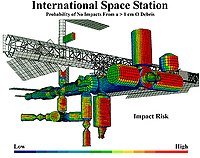
Photo from wikipedia
This study presents a methodology using the correlation of numerical diffusion with the standard two-fluid model to simulate the separated two-phase flow (gas–liquid) in a pipe. Firstly, different numerical schemes… Click to show full abstract
This study presents a methodology using the correlation of numerical diffusion with the standard two-fluid model to simulate the separated two-phase flow (gas–liquid) in a pipe. Firstly, different numerical schemes are examined to investigate the flow characteristics through the water faucet problem. For this, the shock-capturing method is developed to an algorithm scripted in Fortran; and the Force (first-order centred) scheme is selected for the models used in this work, due to the higher accuracy and less computations. For validation of the simulations, the results of instability range are compared to the calculations using the classic Kelvin–Helmholtz instability equation; and then, the methodology is used to evaluate the slug flow initiation and growth in a horizontal pipe. The results showed that the instability range is affected by the wavelengths as a decrease in the wavelengths led to inconsistency of the range. It is found that the short-wavelength perturbations induce the unbounded growth rates, and this halts the convergence of results. To remedy this deficiency, the methodology introduced in this study showed an excellent ability to damp the unbounded growth of instabilities, where the standard model is not well-posed. Indeed, comparing the flow property diagrams for the two studied conditions showed that the wavelengths below the specified cut-off are stabilized, and the converged results are achieved for the flow properties. Finally, for the slug flow initiation, a very good agreement is achieved between the results from the introduced approach and the experimental results.
Journal Title: Journal of the Brazilian Society of Mechanical Sciences and Engineering
Year Published: 2021
Link to full text (if available)
Share on Social Media: Sign Up to like & get
recommendations!